

Finance
Why Are Utility Stocks Down Today
Published: January 18, 2024
Discover why utility stocks are experiencing a downturn in today's finance landscape and how it may affect your investment decisions. Explore the reasons behind this decline and stay informed in the ever-changing financial markets.
(Many of the links in this article redirect to a specific reviewed product. Your purchase of these products through affiliate links helps to generate commission for LiveWell, at no extra cost. Learn more)
Table of Contents
Introduction
Utility stocks have long been considered a stable and reliable investment option for many investors. Known for their consistent dividends and relatively lower volatility compared to other sectors, utility stocks have historically been a go-to choice for those looking for steady income and capital preservation. However, like any other sector, utility stocks are not immune to market fluctuations and can experience periods of decline.
In recent times, utility stocks have been facing challenges that have led to a downturn in their performance. Factors such as declining demand for traditional utilities, regulatory challenges, the impact of renewable energy, and market volatility have all contributed to the downward pressure on utility stocks. Understanding these factors and their impact is crucial for investors and those interested in the finance industry.
This article aims to shed light on the reasons behind the recent decline in utility stocks and provide insights into the key factors driving this trend. While utility stocks may be down today, it is essential to comprehend the broader context and potential implications for investors in the long term.
Factors Impacting Utility Stocks
Several factors have contributed to the recent decline in utility stocks. Understanding these factors is crucial in order to grasp the dynamics affecting this sector and make informed investment decisions. Let’s explore the key factors impacting utility stocks:
- Declining demand for utilities: One of the primary factors affecting utility stocks is the declining demand for traditional utilities. With advancements in technology and a shift towards more energy-efficient practices, consumers are increasingly adopting renewable energy sources and reducing their reliance on traditional utilities. This decrease in demand has put pressure on utility companies, leading to lower revenues and profitability.
- Regulatory challenges and rate cuts: Utility companies operate in a heavily regulated environment, and changes in regulations can significantly impact their financial performance. Regulatory challenges, such as stricter emission standards or regulations promoting renewable energy, can increase costs for utility companies and affect their profitability. Moreover, rate cuts imposed by regulatory bodies can limit a utility company’s ability to generate higher profits and returns.
- Impact of renewable energy: The increasing popularity of renewable energy sources, such as solar and wind power, has disrupted the traditional utility business model. Customers are now able to generate their own electricity or rely on alternative suppliers, reducing their reliance on traditional utility providers. This shift towards renewable energy, while positive from an environmental standpoint, has disrupted the revenue streams of utility companies.
- Market volatility and investor sentiment: Like any other sector, utility stocks are also influenced by overall market conditions and investor sentiment. During periods of market volatility, investors may flock towards perceived safer investments, causing a decline in utility stocks. Additionally, negative sentiment towards the sector, whether due to regulatory concerns or industry-specific challenges, can further exacerbate the decline in utility stock prices.
It is important to note that these factors are not isolated, and they often interact with one another, further impacting utility stocks. For example, regulatory challenges related to renewable energy can be both a driver of declining demand for traditional utilities and an opportunity for utility companies to invest in renewable energy sources themselves.
By understanding the various factors influencing utility stocks, investors can assess the risks and opportunities within the sector. It is essential to closely monitor the evolving landscape and adapt investment strategies accordingly in order to navigate the current challenges and potential future changes in the utility industry.
Declining Demand for Utilities
One of the key factors impacting utility stocks is the declining demand for traditional utilities. This decline can be attributed to several factors and has significant implications for utility companies.
Advancements in technology, changes in consumer behavior, and a greater emphasis on energy efficiency have all contributed to the decreasing demand for traditional utility services. Consumers are now more aware of their energy consumption patterns and are actively seeking ways to reduce their carbon footprint. This includes adopting energy-efficient appliances, implementing smart home technologies, and even generating their own electricity through solar panels.
The rise of renewable energy sources, such as solar and wind power, has further accelerated the decline in demand for traditional utilities. With the decreasing costs of renewable energy installations and government incentives in many countries, more consumers are opting to generate their own electricity. This allows them to be more self-sufficient and reduce their reliance on traditional utility providers.
Furthermore, the increasing popularity of electric vehicles (EVs) has also contributed to the declining demand for utilities. As more consumers transition to electric cars, the demand for gasoline decreases, impacting the revenues of utility companies that operate gas stations or provide gasoline-related services.
While declining demand for utilities poses challenges for the sector, it also opens up opportunities for utility companies to adapt and diversify their offerings. Many utility companies are investing in renewable energy sources themselves, recognizing the shift in consumer preferences and environmental concerns. By incorporating renewable energy into their portfolio, utility companies can leverage the growing demand for cleaner energy and position themselves for future growth.
In addition, utilities have started exploring innovative ways to meet the changing needs of consumers. This includes offering energy management solutions, implementing smart grids, and encouraging energy conservation initiatives. By providing value-added services and promoting energy efficiency, utility companies can potentially mitigate the impact of declining demand and strengthen their position in the market.
Overall, the declining demand for traditional utilities is a significant factor affecting utility stocks. As consumer preferences and technologies continue to evolve, utility companies must adapt to these changes in order to remain relevant and seize new opportunities in the energy sector.
Regulatory Challenges and Rate Cuts
The utility industry operates in a heavily regulated environment, and changes in regulations can have a significant impact on utility stocks. Regulatory challenges and rate cuts pose unique challenges for utility companies and can affect their financial performance.
Regulatory bodies set the rules and standards for utility companies, aiming to ensure fair practices, reliable service, and environmental sustainability. However, changes in regulations can lead to increased costs for utility companies, affecting their profitability. For example, stricter emission standards may require utility companies to invest in expensive equipment to reduce pollution, thereby increasing their operating expenses.
Furthermore, regulations aimed at promoting renewable energy can have both positive and negative implications for utility companies. While the emphasis on renewable energy aligns with the global goal of reducing carbon emissions, it can disrupt the traditional utility business model. Utility companies may face difficulties in transitioning from their reliance on fossil fuels to incorporating renewable energy sources into their infrastructure. This can lead to uncertainties and potential regulatory challenges as they navigate the integration of renewable energy into their operations.
In addition to regulatory challenges, rate cuts imposed by regulatory bodies can impact utility companies’ financial performance. Rate cuts limit a utility company’s ability to generate higher profits, as they are often implemented to protect consumers from excessive price increases. While rate cuts may benefit consumers by keeping utility costs down, they can stifle the revenue growth and profitability of utility companies.
Rate cuts can particularly impact investor sentiment towards utility stocks, as they are often viewed as income-generating investments with stable dividend payments. When dividend payouts are affected by rate cuts, it can create concerns and lead to a decline in investor confidence, thereby putting downward pressure on utility stock prices.
It is worth noting that regulations and rate cuts can vary across different jurisdictions and can significantly impact the financial performance of utility companies operating in those regions. Understanding the regulatory landscape is crucial for investors to assess the potential risks and opportunities associated with utility stocks.
In response to regulatory challenges and rate cuts, utility companies often focus on finding innovative solutions to meet regulatory requirements while maintaining their financial stability. They may invest in research and development to find more cost-effective ways to comply with regulations, explore partnerships with renewable energy providers, or diversify their business models to incorporate new revenue streams into their operations.
Overall, regulatory challenges and rate cuts are factors that impact utility stocks and require utility companies to adapt to changing regulations while maintaining financial performance. By staying informed about regulatory developments and understanding how utility companies are responding to these challenges, investors can make more informed decisions regarding their utility stock investments.
Impact of Renewable Energy
Renewable energy has emerged as a disruptive force in the utility sector, significantly impacting utility stocks. The growing popularity and adoption of renewable energy sources, such as solar and wind power, have reshaped the dynamics of the industry.
One of the major impacts of renewable energy on utility stocks is the changing demand for traditional utility services. As consumers become more environmentally conscious and seek cleaner energy alternatives, the demand for electricity generated from fossil fuels has declined. This shift has led to a decrease in revenues for utility companies reliant on traditional energy sources, impacting their financial performance and stock prices.
In addition to the decline in demand for traditional utilities, the growth of renewable energy sources has also created challenges for utility companies in terms of grid management. Unlike traditional power sources, renewable energy generation is intermittent and depends on factors such as weather conditions. This intermittency poses technical and operational challenges for utility companies in maintaining a stable and reliable power grid.
However, the impact of renewable energy is not entirely negative for utility companies. Many utility companies have recognized the shift towards renewable energy and have started investing in renewable energy infrastructure themselves. By incorporating renewable energy sources into their portfolio, utility companies can diversify their revenue streams and position themselves for long-term growth. This strategic shift allows them to meet the changing demands of consumers and align with sustainability goals.
Moreover, the decreasing costs of renewable energy technologies have made them more economically viable, attracting investment and increasing competition in the sector. This competition has led to innovation and advances in renewable energy solutions, making them more efficient and cost-effective. As the renewable energy sector continues to mature and evolve, utility companies have opportunities to leverage these advancements and integrate renewable energy into their operations.
Furthermore, regulatory initiatives and government incentives aimed at promoting renewable energy adoption have also influenced the impact of renewable energy on utility stocks. Policies such as renewable portfolio standards, feed-in tariffs, and tax credits have encouraged the growth of renewable energy projects and created a favorable business environment for utility companies to invest in renewable energy infrastructure.
It is important for investors to closely monitor the impact of renewable energy on utility stocks and evaluate how utility companies are adapting to this shift. Those utility companies that successfully navigate the transition towards renewable energy and effectively manage their renewable energy assets are likely to be better positioned for growth in the evolving energy landscape.
Market Volatility and Investor Sentiment
Market volatility and investor sentiment play a significant role in impacting utility stocks. As with any sector, utility stocks are influenced by overall market conditions and the emotions and perceptions of investors.
During periods of market volatility, investors tend to seek safe-haven investments that are perceived as more stable and less risky. Utility stocks, known for their steady income streams and relatively lower volatility compared to other sectors, have historically been attractive to investors during uncertain times. However, despite their reputation as defensive investments, utility stocks are not immune to market fluctuations.
When broader market conditions become volatile, utility stocks can experience declines in value along with the rest of the market. Investor sentiment towards the utility sector can turn negative, leading to a sell-off of utility stocks. This downward pressure on utility stock prices can be exacerbated by concerns over factors such as regulatory challenges, rate cuts, or declining demand for utilities, which we have discussed in previous sections.
Additionally, investor sentiment towards the utility sector can be influenced by perceptions of interest rates. Utility stocks are often viewed as income-generating investments due to their relatively higher dividend yields. When interest rates rise, investors may be more inclined to seek alternative investments that offer higher yields. This shift in investor preference can lead to a decrease in demand for utility stocks and subsequently put downward pressure on their prices.
Conversely, when market conditions stabilize and investor confidence improves, utility stocks can experience upward momentum. As investors seek stability and potential income-generating opportunities, utility stocks may become more attractive. This positive sentiment can drive up stock prices and result in capital gains for investors.
It is important for investors to consider the broader market context and investor sentiment when evaluating utility stocks. While utility stocks may experience short-term fluctuations due to market volatility or negative sentiment, it is crucial to assess the long-term fundamentals of the utility sector. Factors such as the stable demand for utilities, the potential for growth in renewable energy investments, and the ability of utility companies to navigate regulatory challenges are essential considerations for investors interested in utility stocks.
By staying informed about market dynamics and monitoring investor sentiment, investors can make more informed decisions regarding their utility stock investments. Assessing the long-term prospects of the utility sector, while acknowledging short-term fluctuations driven by volatility and sentiment, can contribute to a well-rounded investment strategy.
Conclusion
The recent decline in utility stocks can be attributed to various factors, including the declining demand for traditional utilities, regulatory challenges and rate cuts, the impact of renewable energy, and market volatility driven by investor sentiment.
Declining demand for utilities is a result of advancements in technology, changes in consumer behavior, and the increasing adoption of renewable energy sources. This shift in demand has put pressure on utility companies to adapt and diversify their offerings to remain competitive in the evolving energy landscape.
Regulatory challenges and rate cuts pose unique challenges for utility companies, impacting their financial performance. However, these challenges also present opportunities for utility companies to invest in renewable energy and explore innovative solutions to meet regulatory requirements while maintaining their financial stability.
The impact of renewable energy on utility stocks is significant, with the growing popularity and adoption of renewable energy sources reshaping the dynamics of the industry. Utility companies investing in renewable energy infrastructure position themselves for long-term growth and align with sustainability goals.
Market volatility and investor sentiment also play a role in impacting utility stocks. During periods of market volatility, utility stocks may experience declines in value along with the rest of the market. However, in more stable market conditions, utility stocks can be attractive to investors seeking stability and potential income-generating opportunities.
In conclusion, the recent decline in utility stocks is a result of a combination of factors impacting the sector. Understanding these factors and their implications is crucial for investors and individuals interested in the finance industry. By staying informed, assessing long-term prospects, and monitoring market dynamics and investor sentiment, investors can make more informed decisions regarding their utility stock investments and navigate the challenges and potential opportunities in the utility sector.














